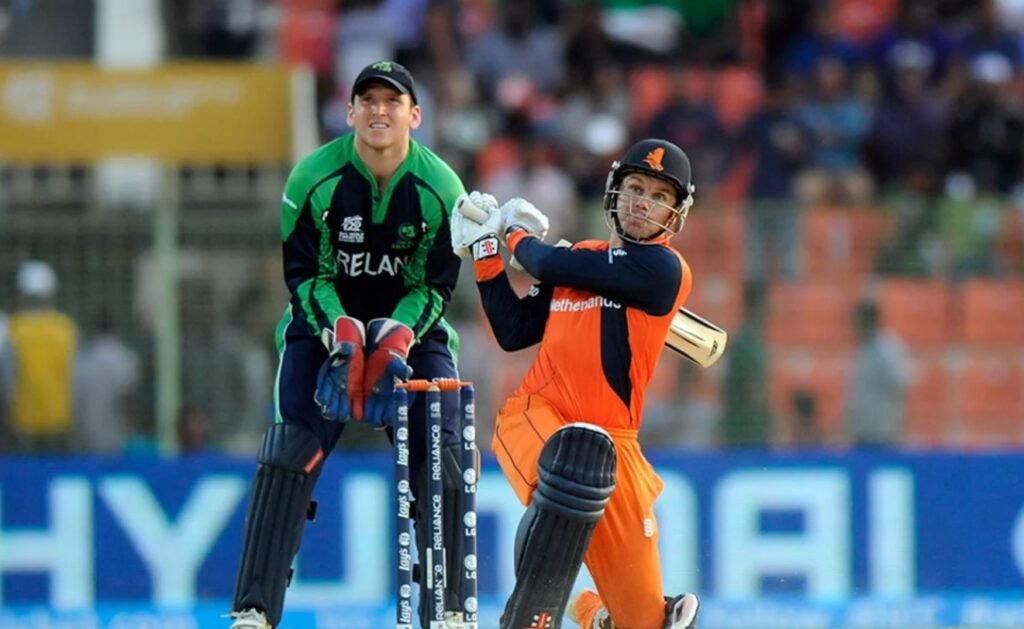
In ICC tournaments, especially the T20 World Cup, the Powerplay overs are very important for batting teams. These first six overs give teams a chance to score a lot of runs quickly because of the fielding restrictions.
During the Powerplay, the openers aim to take advantage of these restrictions by hitting aggressive shots, aiming for boundaries, and rotating the strike well to score as many runs as possible.
A good performance in the Powerplay not only increases the team’s run rate but also sets a strong base for the middle overs. This helps the batters who follow to keep up the momentum and continue scoring quickly throughout the innings.
1. Netherlands vs Ireland

Openers: Stephan Myburgh and Peter Borren
Powerplay Score: 91 runs
The highest powerplay score in T20 World Cup history is 91 runs. The Netherlands achieved this against Ireland on March 21, 2014, in Sylhet. The Dutch batters played aggressively in the second innings, scoring 91 runs in just 36 balls with a strike rate of 244.44. They hit 8 fours and 8 sixes and lost only one wicket during this period. This strong start helped them set a high total and led to a memorable victory for the Netherlands.
2. England’s aggression

Openers: Jason Roy and Alex Hales
Powerplay Score: 89 runs
On March 18, 2016, at Wankhede, England scored 89 runs in the powerplay against South Africa. England’s batters attacked right from the start, hitting 10 boundaries and 4 sixes in just 36 balls. Although they lost three wickets, their aggressive play set the stage for an exciting match, which England eventually won.
ALSO READ: Look at Scotland’s top 10 best scores in the ICC Men’s T20 World Cup history
3. South Africa’s dominance

Openers: Hashim Amla and Quinton de Kock
Powerplay Score: 83 runs
In a T20 World Cup match against England, South Africa scored 83 runs without losing a wicket in the powerplay, the third-highest in the tournament’s history. Amla and de Kock showed great skill, hitting 13 boundaries and 4 sixes in just 36 balls. Despite their strong start, South Africa eventually lost to England in a high-scoring game.
4. India’s commanding chase

Openers: Rohit Sharma and KL Rahul
Powerplay Score: 82 runs
India scored 82 runs in the powerplay against Scotland on November 5, 2021, in Dubai. Batting second, India’s top order started strong and attacked the Scottish bowlers from the beginning. They hit 11 fours and 4 sixes in just 36 balls. Even though they lost two wickets, India’s fast start helped them easily chase the target and win the match comfortably.
5. England’s fierce assault

Openers: Jos Buttler and Alex Hales
Powerplay Score: 70 runs
On November 5, 2022, in a big match against Sri Lanka in Sydney, England’s strong batting lineup scored 70 runs in the powerplay. Their top-order batters hit 9 boundaries and 2 sixes in just 36 balls. With a strike rate of 181.08, England started strong and set a tough target for Sri Lanka.
Even though Sri Lanka’s bowlers managed to slow England down later, the impressive start helped England win the exciting match by four wickets.
6. Sri Lanka’s home turf dominance

Openers: Mahela Jayawardene and Tillakaratne Dilshan
Powerplay Score: 68 runs
On September 27, 2012, in Pallekele, Sri Lanka played a thrilling match against New Zealand. During the powerplay, Sri Lanka scored an impressive 68 runs. The batters were very aggressive, hitting 4 fours and 5 huge sixes in just 36 balls. With a high strike rate of 186.11, Sri Lanka nearly chased down the target set by New Zealand but ended up tying the game.
ALSO READ: Let’s look at the top five captains with the most losses in T20Is
7. England’s spirited effort

- Openers: Jason Roy and Alex Hales
- Powerplay Score: 67 runs
In a thrilling match against New Zealand in Delhi on March 30, 2016, England’s openers Jason Roy and Alex Hales started strong. They scored 67 runs in the first six overs, hitting 10 boundaries and 2 big sixes in just 36 balls. This aggressive batting set a tough target with a high strike rate of 180.55. England kept up their momentum throughout, eventually defeating New Zealand in a hard-fought contest.
8. Netherlands’ fierce start

- Openers: Stephan Myburgh and Michael Swart
- Powerplay Score: 67 runs
In a T20 World Cup match against the United Arab Emirates in Sylhet on March 17, 2014, the Netherlands showed their strong batting skills. They scored 67 runs in the first six overs, hitting 9 boundaries and 3 big sixes in just 36 balls. This aggressive yet skillful play set a tough target for their opponents.
Their high strike rate of 180.55 showed their determination to control the game early on. The Netherlands used their strong start to win the match against UAE by six wickets.
9. Australia’s aggression

- Openers: Aaron Finch and David Warner
- Powerplay Score: 67 runs
In a match against Bangladesh in Dubai (DICS) on November 4, 2021, Australia showed their strong batting skills by scoring 67 runs in the first six overs. They hit 6 boundaries and 4 sixes in just 36 balls, demonstrating their aggressive style of play right from the start.
Even though they lost 2 wickets, Australia maintained a high strike rate of 172.97. They easily achieved the target of 73 runs in just 6.2 overs, winning the match with eight wickets remaining.
10. Pakistan’s competitive total

- Openers: Sharjeel Khan and Ahmed Shehzad
- Powerplay Score: 66 runs
In a thrilling match against New Zealand in Mohali on March 22, 2016, Pakistan showed their strong batting skills. They scored 66 runs in the first six overs, hitting 11 boundaries and one big six in just 36 balls. Despite losing one wicket, Pakistan maintained a high scoring rate of 163.88. However, New Zealand’s disciplined bowling restricted Pakistan from capitalizing on their good start. Despite their efforts, New Zealand won convincingly by 22 runs.
READ MORE:












